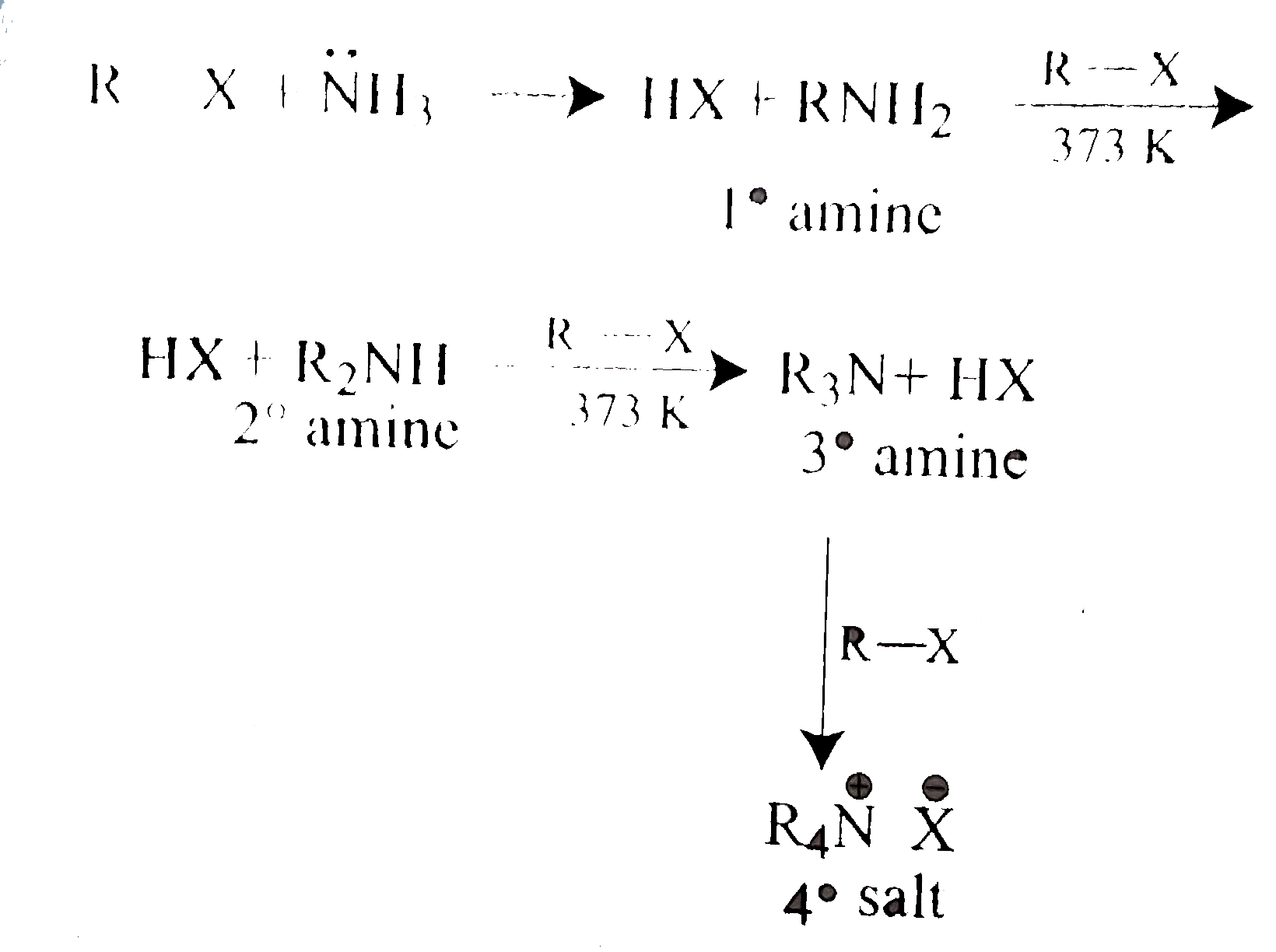What is ammonolysis?
Step-by-Step Solution:
1. Definition of Ammonolysis: Ammonolysis is a chemical reaction that involves the substitution of a halogen atom in an alkyl or benzyl halide with an amino group (NH2) when reacted with ammonia (NH3) in an ethanolic solution.
2. Reactants Involved: The primary reactants in ammonolysis are:
- Alkyl halide (R-X), where R is an alkyl group and X is a halogen (like Cl, Br, or I).
- Ammonia (NH3) in an ethanolic solution.
3. Mechanism of Reaction:
- The reaction proceeds through a nucleophilic substitution mechanism.
- The lone pair of electrons on the nitrogen atom of ammonia acts as a nucleophile.
- This nucleophile attacks the carbon atom that is bonded to the halogen in the alkyl halide.
4. Breaking of Bonds:
- As the nucleophile attacks, the bond between the carbon and the halogen breaks.
- The halogen atom leaves as a halide ion (X-), and the nitrogen atom forms a bond with the carbon atom.
5. Formation of Substituted Ammonium Salt:
- The result of this reaction is the formation of a substituted ammonium salt (R-NH3^+), where the nitrogen is now bonded to the alkyl group.
- The halide ion (X-) is released as a byproduct.
6. Overall Reaction:
- The overall reaction can be summarized as:
R−X+NH3→R−NH+3+X−
- Here, R-X is the alkyl halide, NH3 is ammonia, R-NH3^+ is the substituted ammonium salt, and X- is the halide ion.
- Alkyl halide (R-X), where R is an alkyl group and X is a halogen (like Cl, Br, or I).
- Ammonia (NH3) in an ethanolic solution.
- The reaction proceeds through a nucleophilic substitution mechanism.
- The lone pair of electrons on the nitrogen atom of ammonia acts as a nucleophile.
- This nucleophile attacks the carbon atom that is bonded to the halogen in the alkyl halide.
- As the nucleophile attacks, the bond between the carbon and the halogen breaks.
- The halogen atom leaves as a halide ion (X-), and the nitrogen atom forms a bond with the carbon atom.
- The result of this reaction is the formation of a substituted ammonium salt (R-NH3^+), where the nitrogen is now bonded to the alkyl group.
- The halide ion (X-) is released as a byproduct.
- The overall reaction can be summarized as:
R−X+NH3→R−NH+3+X−
- Here, R-X is the alkyl halide, NH3 is ammonia, R-NH3^+ is the substituted ammonium salt, and X- is the halide ion.
Topper's Solved these Questions
- BOOK - ICSECHAPTER - ORGANIC COMPOUNDS CONTAINING NITROGENEXERCISE - EXERCISE (PART-II DESCRIPTIVE QUESTIONS- SHORT ANSWER QUESTIONS )92videos
ORGANIC COMPOUNDS CONTAINING NITROGEN
- BOOK - ICSECHAPTER - ORGANIC COMPOUNDS CONTAINING NITROGENEXERCISE - EXERCISE (PART-II DESCRIPTIVE QUESTIONS- LONG ANSWER QUESTIONS )57videos
ORGANIC COMPOUNDS CONTAINING NITROGEN
- BOOK - ICSECHAPTER - ORGANIC COMPOUNDS CONTAINING NITROGENEXERCISE - EXERCISE (PART-I OBJECTIVE QUESTIONS)72videos
ORGANIC COMPOUNDS CONTAINING NITROGEN
- BOOK - ICSECHAPTER - ISC QUESTION PAPEREXERCISE - PART-II(SECTION-B)74videos
ISC QUESTION PAPER
- BOOK - ICSECHAPTER - P-BLOCK ELEMENTSEXERCISE - SOURCE BASED QUESTIONS10videos
P-BLOCK ELEMENTS
Similar Questions
Hofmann's ammonolysis reaction.
View SolutionHofmann's ammonolysis reaction.
View SolutionHofmann's ammonolysis reaction.
View SolutionThe presence of a base is needed in the ammonolysis of alkyl halides. Explain.
View SolutionWhy is it difficult to prepare pure amines by ammonolysis of alkyl halides?
View SolutionAssertion : In ammonolysis of alkyl halides , primary amine is obtained as a major product by taking large excess of NH3 .
Reason : The process of cleavage of the C-X bond by ammonia molecule is known as ammonolysis .View SolutionWhat is anaphylaxis? What are the symptoms of it?
View SolutionWhat is osmosis ? What is the difference between osmosis and diffusion?
View SolutionWrite chemical equations for the following reactions:
(i) Reaction of ethanolic NH3 with C2H5Cl.
(ii) Ammonolysis of benzyl chloride and reaction of amine so formed with two moles of CH3Cl.View SolutionConsider the Hofmann ammonolysis reaction :
R−X+..NH3→HX+RNH21∘amineR−X−−→373K

If R=Me3C−(t−butyl), the correct order of basic character of the above amines in aqueous medium is :View Solution

